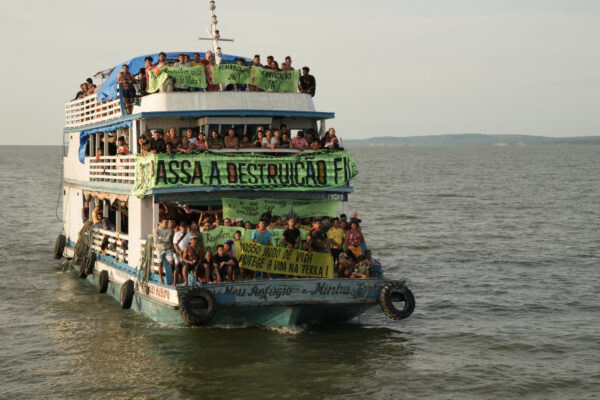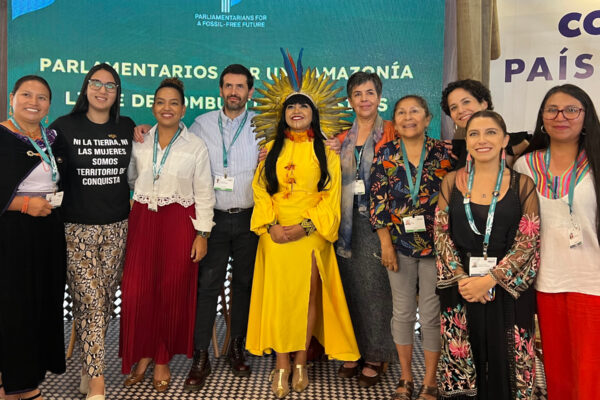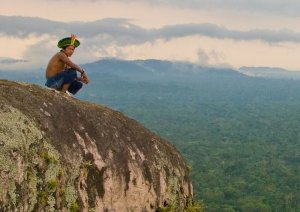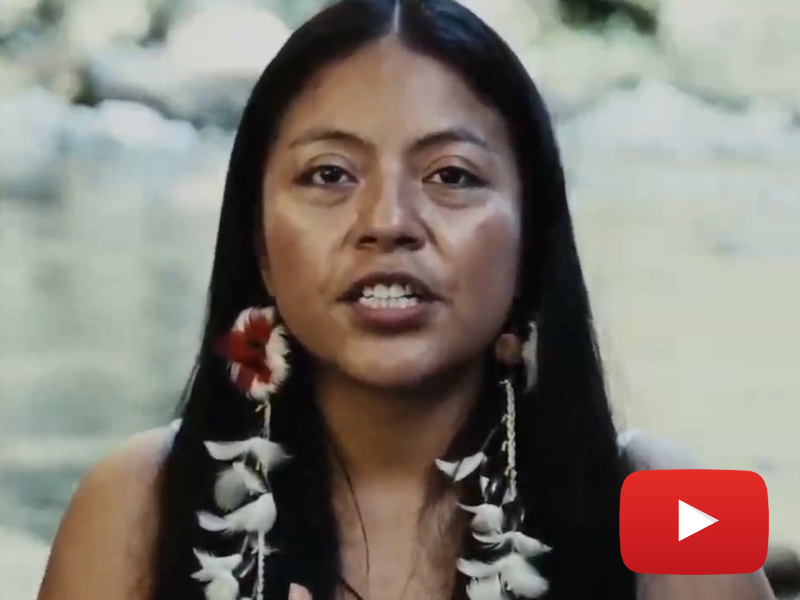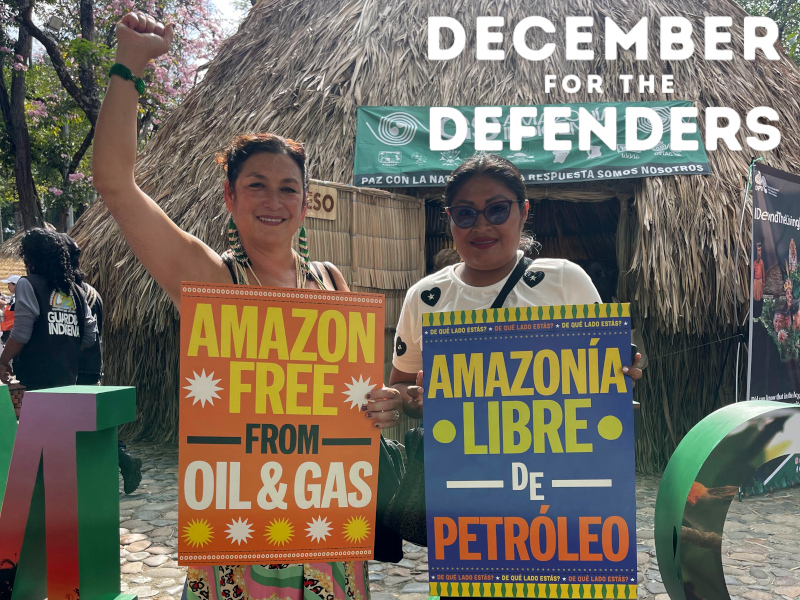In the men’s house, a ventilated open-air space at the center of the village, Kayapó Mebengôkre elders pause for an afternoon meal. It’s May, and the rainy season is winding down, making for a hot but pleasant afternoon.
The meal is berarubu, a traditional dish from the Menkragnoti Indigenous Territory, the largest of five territories occupied by the Kayapó in southern Pará and northern Mato Grosso. Wrapped in banana leaves, the dish is made of cassava and wild pig, the most prized game animal in these preserved forests. A thermos of water from the Curuaés River, which borders the village, accompanies the meal.
Soy plantations, slowly encroaching on the Menkragnoti territory and its neighbors, have begun altering daily Kayapó practices like this communal meal. Locals say river water, game, and fish are contaminated by pesticides used on soy crops that are growing closer to their borders. They now avoid hunting near the edges of their land.
Kayapó leaders expect this to worsen with the arrival of a colossal infrastructure project championed by both left- and right-wing governments: the Ferrogrão railway.
“Just hearing the name ‘Ferrogrão’ makes me think things will get worse,” says Chief Tkak Djmati of Mopkrore village, shortly before sharing berarubu. His comments were translated by a Kayapó interpreter.
“Soy farming will increase a lot. When it rains, the pesticides flow into the river. We have no wells to rely on. There’s nowhere to run, and all our children get sick,” Djmati explains.
The Ferrogrão project outlines a 933-km railway stretching from Sinop, Mato Grosso – where 40% of the state’s soy is grown – to Miritituba port in Itaituba, Pará. There, soy and corn traders dominate a sprawling complex of silos, warehouses, and private river terminals.
The railway traces the BR-163 highway, which is already overwhelmed by soy transport. At harvest time, 2,000 to 4,000 trucks jam the route daily, forming queues at silos, checkpoints, gas stations, and ports.
President Lula’s administration has embraced the project, supporting major soy operators like Cargill, Bunge, and Amaggi. The railway’s studies and designs are included in the federal government’s Growth Acceleration Program (PAC), with a concession auction expected in 2026.
A recently approved bill loosening environmental licensing could expedite Ferrogrão’s construction. The law allows the government to classify projects as “strategic,” streamlining them through a one-phase, one-year review. It also excludes unrecognized Indigenous lands from environmental assessments – such as those inhabited by Munduruku people near Itaituba.
Despite bureaucratic setbacks, the federal government remains committed to finalizing the concession. On the ground, the pressure is already palpable.
Kayapó territories lie 30 to 48 km from the planned railway. Munduruku settlements in Itaituba are even closer, some less than 6 km away. Communities of fishers at the Jamanxim National Park entrance, and residents near future railway branches, expect forced displacement.
None of these groups have been consulted.
The government claims the railway will enable cargo traceability and reduce illegal deforestation, affecting only terminal zones. “The railway will ease pressure on nearby communities by promoting more efficient, sustainable transport,” says the President’s Office.
Folha reporters followed the railway route from Sinop to Itaituba, visiting traditional communities along the way – some meters away, others kilometers.
In this part of Brazil, everything revolves around soy and corn. Even forested communities now find themselves surrounded by monoculture.
“February and March on BR-163 is hell,” says Ilson José Redivo, president of the Sinop Rural Union. “Trucks line up endlessly. In Miritituba, each trader runs its own port terminal.”
Redivo estimates Ferrogrão will cut freight costs in half. “It will pay for itself in two or three years.”
Today, truckers endure hours-long waits to reach Miritituba, where cargo ships sail to Santarém and Barcarena ports, mainly for export.
Menkragnoti lies to the right of the highway en route to Itaituba. This 4.9 million-hectare rainforest sits near Castelo dos Sonhos, the closest urban district.
From Castelo dos Sonhos to the Pykatoti village is a 61-km dirt road. Originally a surveillance post, the village now faces encroaching soy and corn farms.
“That pasture became soy last year. Now it’s all corn,” says Chief Abiri Kayapó of Pykatoti. “Because of those plantations, our water is unusable.”
Kayapós report shrinking territory and increasing pesticide exposure. “We’re eating contaminated fish. The boars and tapirs we hunt must be poisoned too. The railway will bring more invasion, more soy, more outsiders,” says Abiri.
The same fears echo in Baú territory next door. Their leaders have approved consultation protocols and seek to voice opposition to Ferrogrão in official forums.
With so much soy on the road, truck crashes have created new job markets. Near Jamanxim Park, three men scoop soy from a wrecked 57-ton truck. Paid by insurers, they earn R$150 per day filling 60 sacks. “We don’t wish harm, but this is our livelihood,” says Carlos Henrique.
Further down the road, tragedy struck in Aruri village. Elda dos Santos, 75, lost her 21-year-old grandson to a truck accident in 2024. “I arrived 45 years ago. I don’t want to leave,” she says.
Aruri, a fishing village on the Aruri River, is one of few communities officially listed in environmental impact reports. The railway passes just 345 meters away, requiring home demolitions and relocations.
With 42 families, Aruri has received no government or company visits about the project. Instead, trucking firms have pressured residents to oppose the railway. Still, community president Zuza, 67, insists: “There’s no better place. If I’m hungry, I fish. I wouldn’t know where else to go.”
At the Tapajós River, barges dominate the landscape. Numerous terminals serve commodity giants, disrupting nearby Munduruku villages. These communities were displaced decades ago, pushed into small urban areas like Praia do Índio and Praia do Mangue.
Their ancestral lands, now 5.8 to 8.5 km from the railway, are off-limits. Industrial expansion disrupts fishing and sacred sites. One terminal construction was halted after uncovering a Munduruku cemetery. “That’s a sacred place. If disturbed, we suffer the consequences,” says shaman Fabiano Karu Pen.
Chief Tiago Ikõbaca Kpu points to soil rich in bacaúbas, signaling ancient Indigenous presence. “Now it’s all silos and warehouses,” he says. A lake once used for fishing has been filled for construction.
Near Sawré Ba’pim, a protected forest zone, soy farms have finally arrived. “It started small. Now they’ve planted soy for the first time,” says leader Bonifácio Saw Munduruku, who has fought for 20 years for territorial recognition. “There’s a cloud of poison over the community. The creek is polluted. Our buriti, açaí, and fish are dying.”



